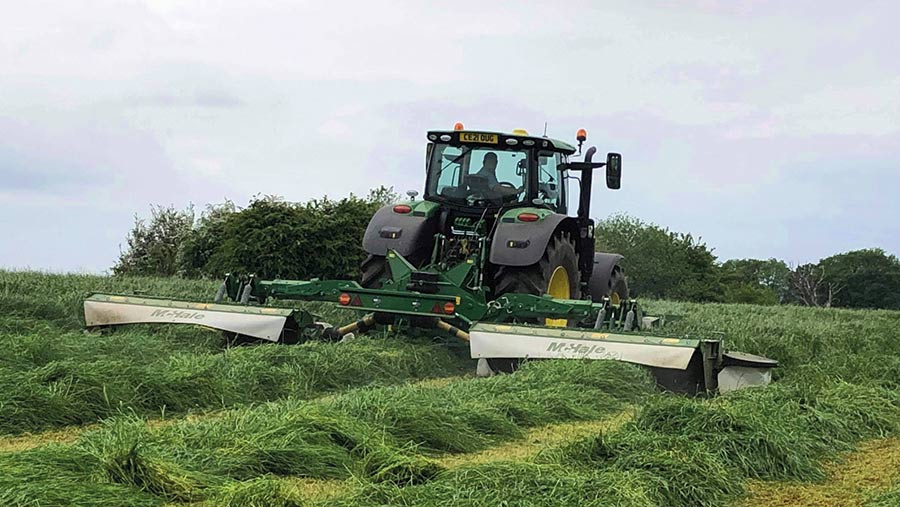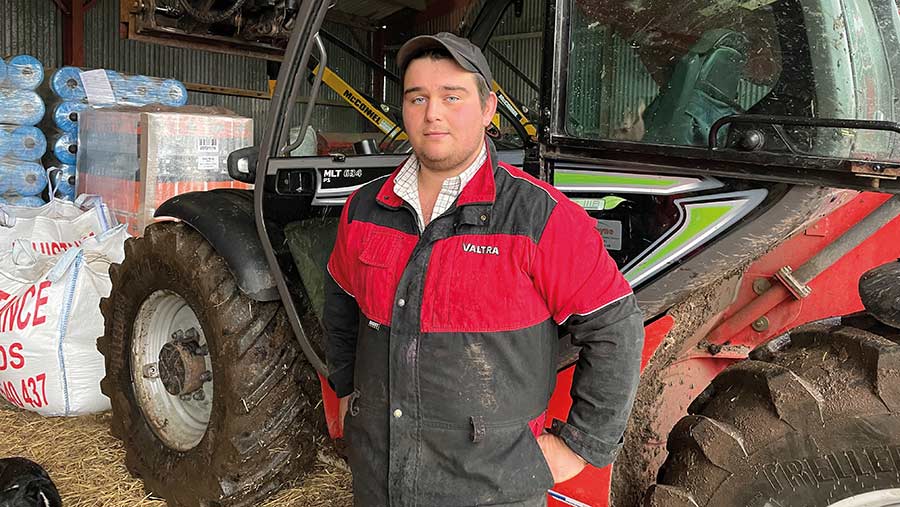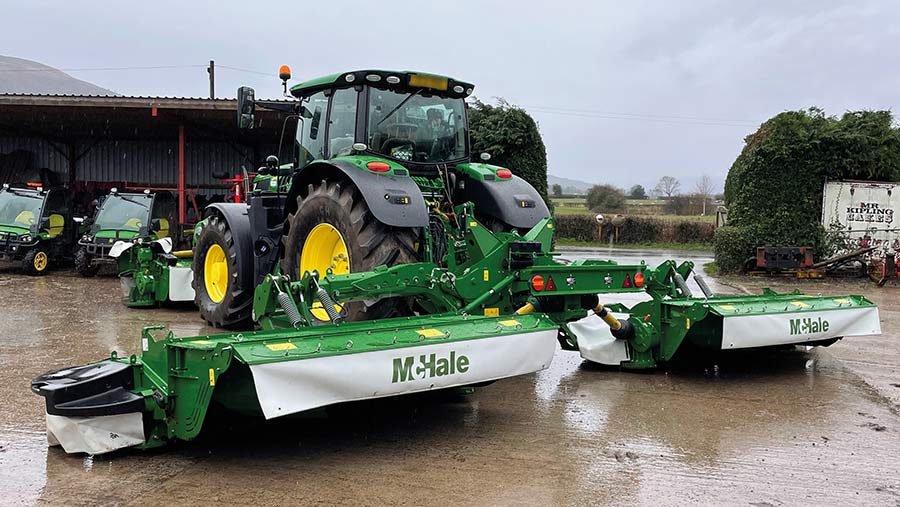Driver’s view: MRI Whistance’s McHale Pro Glide B9000 mowers
 The mowers run on a Deere 6175R chipped to 220hp © James Andrews
The mowers run on a Deere 6175R chipped to 220hp © James Andrews We get the lowdown on the McHale triple mowers run by Monmouthshire contractors MRI Whistance, driven by George Whistance.
See also: Ultimate guide to buying a round baler 2022
Business facts – MRI Whistance, Monmouthshire
- Mowing 770ha
- Round bale hay and silage 25,000-30,000
- Other work Big square baling, combining, cultivation and drilling, groundwork, fencing, tree shearing
- Farming 40ha sheep and beef

George Whistance © James Andrews
What made you choose McHale triple mowers?
We’ve got some varied terrain in our area, so have a good mix of mounted and trailed mowers to suit different situations.
These include John Deere, Kverneland and McHale machines, all of which have their good and bad points.
Up until two years ago, the biggest setup we had was a front and rear combination.
However, we were keen to get a bit more output and we liked the fact that triples are so much better balanced.
There’s a huge turning force on the link arms with all big offset mowers, so we ended up running with a set of counterweights to make them more manageable.
We already had McHale front mowers, so it was an obvious choice to get the same at the rear.
That said, we did look at the competition before making our final decision, pricing up models from Kverneland, John Deere and Pottinger.
They were all good, and we particularly liked the Pottinger set, but McHale just clinched it.
We like the fact they’re so solidly built, with thick gears in the beds. However, the biggest reason for buying was that our local dealer, Ian Mills at Western Farm Services, is so good to work with.
We opted for the Pro Glide B9000 set that gives a total cut of 8.75m when teamed with the F3100 front mower – it cost us just under £30,000.
What tractor are they run on?
As of last season, we’ve been running the mowers on a John Deere 6175R fitted with a Steinbauer chip that bumps the output up to 220hp.
This gives us plenty of power, so that in good going we can cover 4-6ha/hour, dropping back to 3-4ha/hour in particularly heavy crops.
When we first got the triples in 2020, we ran them on a 6155R, which was pushed to its limit.
In fairness, it did do the job, but we couldn’t go anywhere near fast enough to get the maximum output from the mowers.
The 6175R is our first tractor with autosteer, which has transformed the mowing job.
On flat going I have the mowers pushed out to the full 8.75m working width and set the implement width in the GPS just under this.
Then, when I move to steeper ground, I have them pulled right in to avoid getting any misses between the beds.
When doing this, I switch to another implement profile in the GPS with a narrower working width.
McHale Pro Glide B9000 butterfly*
*Paired with F3100 front
- Working width 8.15-8.75m
- Telescopic adjustment 30cm each side
- Discs Seven each side
- Conditioners Steel tine with 700/1,000rpm option
- Transport height and width 4×2.98m
- Weight 2,760kg
- Power requirement 200hp
- Swath width 1.3-2.3m
- List price £48,728 rear; £18,672 front
How has it performed?
We have been pleased with the output and the quality of cut, particularly when we’re pushing on in heavy crops – they just seem to effortlessly eat grass.
The mowers also have some seriously powerful tine conditioners, with a two-speed gearbox that can run at 700rpm or 1,000rpm.
The 700rpm setting is more than aggressive enough for us and we’ve rarely needed to use the faster speed.
McHale has put a lot of metal into the construction and they are a heavy set of mowers, but they’re so well balanced and have such a good suspension system that you don’t really notice the weight.
We have been particularly impressed with the contour-following on the rear butterfly and front mower.
Both are pulled from the front of the bed rather than being pushed, which means they float over bumps and obstacles.
The front mower has sprung suspension, but the rears have a hydraulic down-pressure system with accumulators to keep them hugging the ground.
Western Farm Services set this at 100bar when we got them, and it has proved to be about right.
We have played around with the pressures a bit, but haven’t managed to improve on the standard setting.
It’s also worth noting that they fold over centre, making them narrower than some other triples at the top.
This helps when we’re travelling down narrow lanes and going through tight gateways.
Even so, there are still some places where we can’t use them, which is where the front-and-rears and trailed sets come in.
Where we can, we’ll also use a trailed to open up and do the back swath, so that we can just swing in with the triples to knock down the body of the field.

© James Andrews
What could be improved?
As our mowers have side-shift there isn’t a proper break-back system.
The geometry of the mowers means they will ride up over obstacles like stones and manholes, but I’m always wary that I’d do some serious damage if I clipped something particularly solid such as a tree or telegraph pole.
I’m not sure if it’s even possible to add this with side-shift, but it would be reassuring.
Also, the end guards on the rear mowers flop over centre with gravity, rather than having a hydraulic ram on them like Kuhn and John Deere versions.
They work fine most of the time, but occasionally they get stuck, meaning you need to open them for another go.
Would you have another?
Based on their current performance and the dealer backup, yes.
They leave a good finish, push on well and follow the ground brilliantly.
However, we’ll need to see how we get on with them once they’ve done more work.
There are also plenty of other good mowers out there, so if there is a set we like the look of more, or we get offered a good deal, we would consider changing brands.

